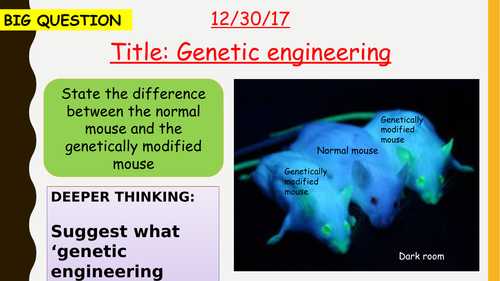

Genetic engineering lesson created in accordance to the NEW AQA Specification (9-1). Designed for higher ability (trilogy/combined) class, although content can be adjusted to suit any ability. Includes: embedded videos and timers, slide animations, practice questions with answers on slides, worksheet and an interactive quiz. NB: If you are unable to play videos a URL link can be found in the slide notes.
AQA spec link: 4.6.2.4
Relevant chapter: B13 Variation and evolution. AQA Biology trilogy edition textbook-Page 184-185.
Students are required to know the following;
Students should be able to describe genetic engineering as a process which involves modifying the genome of an organism by introducing a gene from another organism to give a desired characteristic.
Plant crops have been genetically engineered to be resistant to diseases or to produce bigger better fruits.
Bacterial cells have been genetically engineered to produce useful substances such as human insulin to treat diabetes.
Students should be able to explain the potential benefits and risks of genetic engineering in agriculture and in medicine and that
some people have objections.
In genetic engineering, genes from the chromosomes of humans and other organisms can be ‘cut out’ and transferred to cells of
other organisms. Crops that have had their genes modified in this way are called
genetically modified (GM) crops. GM crops include ones that are resistant to insect attack or to herbicides. GM crops generally show increased yields.
Concerns about GM crops include the effect on populations of wild flowers and insects. Some people feel the effects of eating GM crops
on human health have not been fully explored.
Modern medical research is exploring the possibility of genetic modification to overcome some inherited disorders.
(HT) Students should be able to describe the main steps in the process of genetic engineering.
In genetic engineering:
• enzymes are used to isolate the required gene; this gene is inserted into a vector, usually a bacterial plasmid or a virus
• the vector is used to insert the gene into the
required cells
• genes are transferred to the cells of animals, plants, or microorganisms at an early stage (egg or embryo) in their development so that they develop with desired characteristics.
AQA spec link: 4.6.2.4
Relevant chapter: B13 Variation and evolution. AQA Biology trilogy edition textbook-Page 184-185.
Students are required to know the following;
Students should be able to describe genetic engineering as a process which involves modifying the genome of an organism by introducing a gene from another organism to give a desired characteristic.
Plant crops have been genetically engineered to be resistant to diseases or to produce bigger better fruits.
Bacterial cells have been genetically engineered to produce useful substances such as human insulin to treat diabetes.
Students should be able to explain the potential benefits and risks of genetic engineering in agriculture and in medicine and that
some people have objections.
In genetic engineering, genes from the chromosomes of humans and other organisms can be ‘cut out’ and transferred to cells of
other organisms. Crops that have had their genes modified in this way are called
genetically modified (GM) crops. GM crops include ones that are resistant to insect attack or to herbicides. GM crops generally show increased yields.
Concerns about GM crops include the effect on populations of wild flowers and insects. Some people feel the effects of eating GM crops
on human health have not been fully explored.
Modern medical research is exploring the possibility of genetic modification to overcome some inherited disorders.
(HT) Students should be able to describe the main steps in the process of genetic engineering.
In genetic engineering:
• enzymes are used to isolate the required gene; this gene is inserted into a vector, usually a bacterial plasmid or a virus
• the vector is used to insert the gene into the
required cells
• genes are transferred to the cells of animals, plants, or microorganisms at an early stage (egg or embryo) in their development so that they develop with desired characteristics.
Get this resource as part of a bundle and save up to 20%
A bundle is a package of resources grouped together to teach a particular topic, or a series of lessons, in one place.
Something went wrong, please try again later.
Report this resourceto let us know if it violates our terms and conditions.
Our customer service team will review your report and will be in touch.
£4.00
